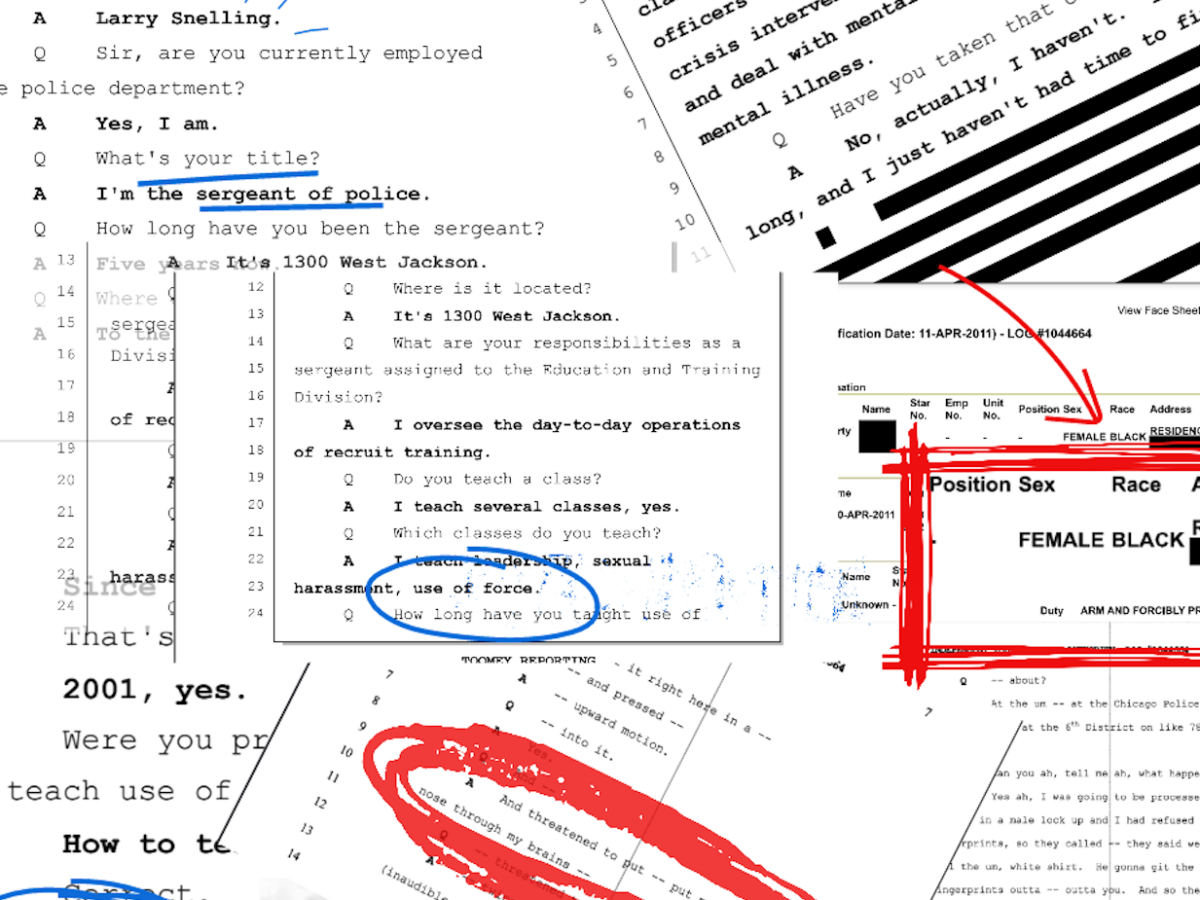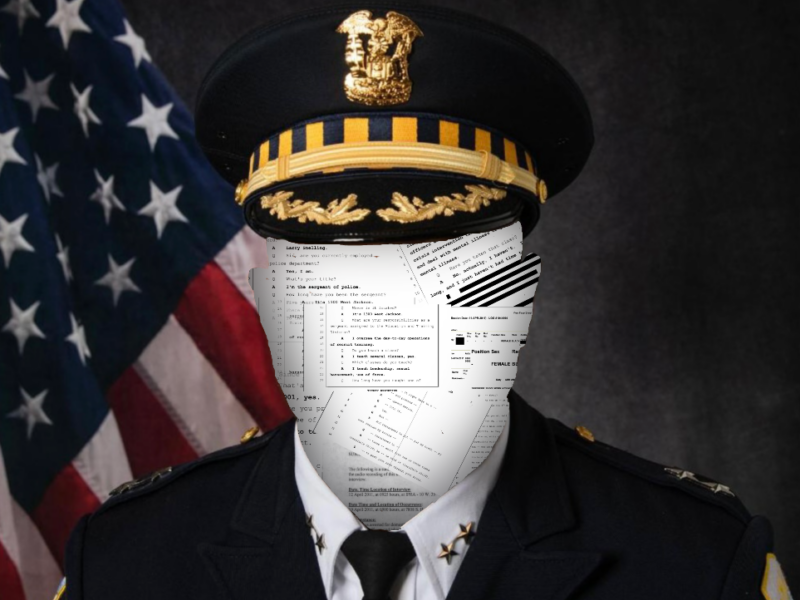In 1997, Larry Snelling was implicated as one of several officers who coerced a man into bringing them a gun by threatening they’d plant drugs on him if he didn’t cooperate. According to records obtained by the Weekly, a sting operation conducted by Internal Affairs as a result of a complaint the man filed snared three officers close to Snelling, including his partner at the time, in the scheme.
Snelling is Mayor Brandon Johnson’s pick to be the Chicago Police Department’s (CPD’s) next superintendent. He was short-listed for the top position by the new Community Commission on Public Safety and Accountability (CCPSA) after a months-long search, and Johnson announced he’d be his choice on August 14. The City Council has yet to confirm him. The Mayor’s Office did not respond to the Weekly’s questions by press time.
CCPSA president Anthony Driver told the Weekly that the commission reviewed Snelling’s entire disciplinary history and that he “still 100 percent” supports him becoming the next superintendent.
“The vast majority of Chicagoans I’ve talked to support him,” Driver said. “We would not have put his name forward if we thought there was something in his record that disqualified him. The best indicator of a changed person is changed behavior, and I think the last twenty-five years of his record speaks to that.”
Chicago mayors and the department’s top brass have long prioritized taking guns off the street, and the officers who do this kind of work are often rewarded with promotions or other commendations. The tactics employed to accomplish this have occasionally been illegal. In its 2017 investigation of CPD, the Justice Department highlighted “allegations that CPD officers attempt to gain information about crime using methods that undermine CPD legitimacy and may also be unlawful” and reported that the investigation “indicates that these practices in fact exist.”
The events surrounding the sting operation began a couple blocks south of Sherman Park in Englewood on a sweltering July day in 1997. A thirty-year-old man and his girlfriend were sitting on the porch of her house when four officers—Snelling, his partner Leroy Horton, Robert Haile, and Terance Nalls—pulled up. In their sworn statements to Internal Affairs investigators, the officers later claimed they were responding to a narcotics call. They handcuffed and searched the man and placed him in the back of one of their squad cars while they continued combing through the area surrounding his girlfriend’s home.
The man later alleged that one officer then came back to the car and showed him “six blue tinted zip-lock bags containing rock cocaine,” and insisted the drugs were his. The officers never inventoried the baggies, and all later claimed not to have found any drugs on the man or that they even arrested him. Instead, they said they’d brought him to the station to fill out a contact card.
According to a complaint the man later filed, the four officers took him to the 7th District in West Englewood. After arriving at the station, the man—who had been arrested less than four months before on a separate drug offense and was on parole for a prior conviction—said that the officers, including Snelling, told him that they’d let him go if he promised to bring them a gun.
Should he fail to do so, the officers said the next time they saw him they would plant drugs on him and send him to prison, the man alleged.
“Don’t fuck me over,” the man alleged Haile told him, or he’d “have his black ass back in the penitentiary.”
Haile then handed the man his business card and gave him specific instructions to page him at his number with the code “57” and to place the gun in “the hole of a tree” behind his girlfriend’s house where they would know to pick it up. Then they released him.
They found traces of the ultraviolet powder on the officers’ hands, indicating that each had separately held the planted gun.
Two days later, the man called Internal Affairs to report Snelling, Haile, Horton, and Nalls. He was interviewed by investigators a few days later, and he gave them the business card. It bore Haile’s full name and his title, “preliminary investigator,” as well as a freemason insignia and the motto “Often Tried, Never Denied.”
After hearing the man’s allegations, Internal Affairs investigators decided to conduct an “integrity check” of the officers with a sting operation. They obtained a .357 magnum from CPD’s Education and Training Division and had it dusted with an ultraviolet powder so that anyone who touched it would have invisible traces on their hands and clothes. They put the handgun in a white plastic bag along with ten small zip-lock bags containing a rocky white substance made to look like crack.
They placed the white plastic bag in the hole in the tree behind the man’s girlfriend’s house and paged Haile.
Haile called the man, who told him where to find the bag. As expected, Haile, Horton, and Nalls drove to the house in an unmarked vehicle shortly after the call. Unbeknownst to the officers, Internal Affairs was surveilling and recording their movements. Investigators witnessed Haile get out of the car, quickly retrieve the white plastic bag from inside of the tree, and then take it back into the car before opening it up and looking inside.
Rather than driving straight back to the station with the recovered gun the officers made a street stop of a group of people and searched the area around them as Internal Affairs investigators continued to surveil them. Back at the station, investigators saw Haile carry the handgun inside. The officers didn’t bring in the baggies of fake crack or report their recovery. In their case report, they claimed an “unknown citizen” paged them and told them he’d seen teenagers put the bag in the tree.
Having witnessed the officers seize the planted gun and place it in evidence as if they had obtained it in the course of normal police business, Internal Affairs investigators stopped them as they were leaving and informed them of the man’s allegations. They found traces of the ultraviolet powder on the officers’ hands, indicating that each had separately held the planted gun.
Investigators later served Snelling with a notice that he was also one of the accused officers.
In formal statements to investigators, all four denied that they had threatened the man with prison time or that they had ever told him to get them a gun. Haile claimed that after removing the gun from the bag, he’d balled up the bag and thrown it away without ever seeing the zip-lock baggies with fake crack cocaine.
Internal Affairs found the allegations against Haile, Horton, and Nalls sustained, and they all served short suspensions of no more than five days.
Snelling, who was formally accused of having “threatened to plant drugs on the complainant if [he] did not get him a gun” before releasing the man without charges, denied the allegations. Investigators subsequently found the complaint against him not sustained, meaning there wasn’t enough evidence to prove or disprove the allegations.
The CPD’s press office did not respond to the Weekly’s request for comment.
Update September 1, 2023: The CCPSA will hold a public forum on Thursday, September 7 at 6:00 p.m. at the National Museum of Mexican Art where Chief Snelling will answer questions from the commission and the public. To submit questions or comments for Snelling, fill out this form.
Max Blaisdell is a fellow with the Invisible Institute and a staff writer for the Hyde Park Herald.
Read more in the Weekly’s Series on Larry snelling
‘Doesn’t Make it Wrong’
CPD Chief Larry Snelling testified in 2015 that an officer’s use of force was appropriate, but IPRA and the then-superintendent found otherwise.
Larry Snelling Garnered Multiple Use-of-Force Complaints in the 1990s
The mayor’s pick to lead CPD was accused of slapping and punching young men when he was a patrol officer on the South Side.




YOUR ARTICLE OF 8/23/23, CONCERNING NEW CPD POLICE CHIEF SNELLING, REFERENCED AN UNSUBSTANTIATED CIVILIAN COMPLAINT, OF POLICE WRONGDOING, THAT ALLEGEDLY OCCURRED, TWENTY-SIX YEARS AGO,
IN ’97. IT IS TO BE NOTED THAT SNELLING IS OF AFRICAN AMERICAN ANCESTRY (*AND THEREFORE, SUBJECT TO EXACTING MEDIA SCRUTINY, FOR REASONS HAVING TO DO WITH RACIALLY IMBALANCED REPORTING IN CHICAGO/ LACK OF JOURNALISTIC INTEGRITY, WHICH WILL MOST LIKELY BE BORNE OUT BY YOUR EXPECTED DECLINATION, TO PUBLISH A STORY, REGARDING SIMILARLY SITUATED COOK COUNTY SHERIFF TOM DART, TO WIT : ARE YOU AWARE THAT THE LATTER WAS IMPLICATED IN COVERING UP A HATE CRIME, DEPICTING A BLACK LYNCHING, IN 2016? AS WITH COMPARATOR SNELLING IT IS OF RELEVANT NOTE, TO CITE ETHNICITY, AS DART IS OF CAUCASIAN ANCESTRY. WANNA KNOW MORE?
This “reverend” is full of it and playing the race card just like white racist do. Crooks, thugs as police or everyone else is called on their bs as they should be. This argument is useless, stupid.
This narrative certainly raises legitimate questions about Officer Snelling escaping accountability when his three partners were suspended.
TO GOD BE THE GLORY!! For allowing Larry SNELLING to be recommended to Chicago Mayor Brandon Johnson.
I as an Urban Translator/ President of United In Peace, Inc Salute the Mayor for picking him as Chicago’s next CPD Superintendent in the name of Community Safety purposefully focused on Fairness and Community Law ( ZERO Tolerance for Senseless Violence [including Domestic Violence] Shootings and Killings; The Abuse / Rape of Women and Children; The Abuse/ Robbery of Elders and Seniors)
you are on it.
THERES NO SUCH THING AS A GOOD COP MY SUPERVISOR WOULD TELL ME. HE ALSO TOLD ME THAT THE ONLY GOOD COPS ARE FORCED TO RESIGN, FIRED OR ACCIDENTALLY KILLED IN THE LINE OF DUTY.
Dear southsideweekly.com admin, Keep the good content coming!